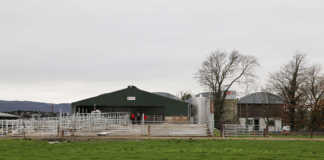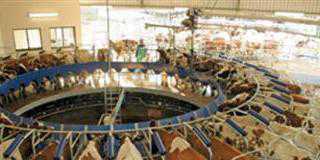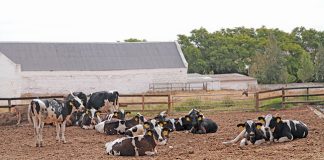The Reynshire Stud herd consists of 520 animals of which around 230 are in milk at any one time. Its udder health and milk quality programme is based on sound, but cost-effective strategic principles.
A finalist in this year’s Free State Master Dairy Farmer competition, Riaan Reynders concentrates on udder health, a uniform milking and hygiene routine, the correct management and operation of the milking machine, efficient cleaning of the dairy equipment, and monitoring the herd’s udder health and the milk’s bacterial level.
Afgri’s Semi Complete total mixed ration (TMR) system also makes an important contribution.
Non-negotiable objectives
Assisted by Dr Vincent Turner, a specialist veterinarian involved with the Reynshire herd since 1999, Riaan established a number of objectives that are regularly measured for success of the programme:
- The somatic cell count (SCC) of the milk in the bulk tank may not exceed 250 000 cells/mâ„“.
- The milk of no more than 10% of the cows in the herd may have a milk SCC of above 500 000 cells/mâ„“.
- The milk of no more than 20% of the cows in the herd may have a milk SCC of above 250 000 cells/mâ„“.
- No more than 2,5% of the cows in the herd may show clinical mastitis symptoms per month.
- The E. coli count may not exceed 35/mâ„“.
- The coliform count may not exceed 20/mâ„“.
- The Total Plate Count may not exceed 10 000/mâ„“.
“Maintaining excellent udder health and milk quality over the years has enabled us to consistently meet these parameters,” Riaan explains.
Dr Turner points out that milk samples tested for mastitis-causing bacteria are from cows recorded in the official Milk Recording Programme:
- Cows are selected according to their SCC results.
- All cows are tested at drying off and again at calving to determine the success of the dry cow therapy.
- Before treatment, samples are taken from clinical mastitis cases to assess any change in the bacteria affecting the herd’s udder health.
“This strict control of milk quality enables us to detect problems in individual cows early,” Dr Turner explains.
“We measure the bacterial parameters in the bulk milk every second day. I am proud to be professionally associated with the herd and commend Riaan and his staff on the high standard of udder health and milk quality they consistently achieve.”
“Ongoing monitoring decreases the risk of poor udder health and consequently the impact on milk production,” Riaan explains.
“It takes time and money, but the return on investment is excellent. No dairyman can afford a disease time bomb in his herd.
“The average daily milk production of the Reynshire cows fluctuates between 25â„“ and 26â„“ per cow, exceptionally high for Ayrshires. The total daily milk production is about 5 500â„“.
“We milk lactation groups of heifers, second lactation cows, third lactation cows, and fourthplus lactation cows. “The breed is known for its longevity and I have cows of 11 years old and 12 years old that are still in milk.”
TMR or silage?
Riaan has switched to Afgri’s semi-complete total mixed ration (TMR) system. “In the past, our feeding system consisted of maize silage made on the farm, as well as eragrostis and teff hay. It took a lot of effort and we constantly had to face risks such as the exceptionally high rainfall of the past season.
"Early on in the season, the foggage grew very well, but the high rainfall later on caused a marked decline in quality, problems in the ensiling process, and an increased possibility of elevated toxin levels. Feed has to be bought in at high cost when the silage supply fails.
“Along with these problems, the ever-increasing cost of ensiling prompted the switch to a TMR system. Silage-based feeding had simply become too expensive,” Riaan explains. “For example, before switching to TMR we used 45l diesel per day. Now we use 65l per week.”
With the semi-complete TMR system, adult cows receive 21kg pellets per day and young cows 19kg pellets per day, all supplemented ad lib by hay cut and baled on the farm. Heifers to be inseminated receive a concentrate and teff mixture, heifers older than six months are kept on planted pasture and heifers younger than six months are fed Afgri’s Scientific 21% calf pellets.
Eragrostis curvula and Eragrostis tef pastures, well fertilised early in the season, are first cut at a young stage to stimulate vigorous regrowth for a second cutting. In addition, grazing pasture heavily makes fertilisation easier and ensures optimum pasture use.
Pastures for summer grazing are prepared as soon as the animals are moved to the winter grazing, and vice versa, in a programme aimed at moisture conservation. Heavily pregnant and dry cows run on the vlei areas in summer. In winter, cows run on maize stover and pregnant heifers on green feed and on the vlei areas in summer.
Riaan and his wife Marlize bought the 480ha farm Vaalhoek from Marlize’s father Jaap Zietsman in 2008. Around 100ha is under pasture, a balance of natural veld and vlei. The dairy is the backbone of the farm, but Riaan also plants sunflower, soya beans and maize on 200ha.
Contact Riaan Reynders on 082 4171 344 or email [email protected].
Caption:
Riaan’s ideal Ayrshire cow has a top class udder, strong legs and excellent feed conversions. The herd is artificially inseminated and Riaan subscribes to the merits of a very broad genetic base.
ANNELIE COLEMAN













